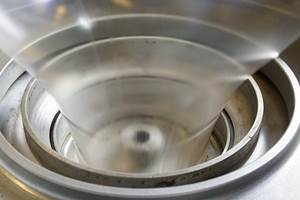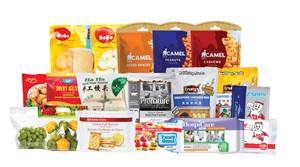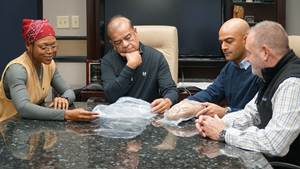Stretching the Limits of Film Innovation
The four partners who started FlexTech Packaging Inc. in Cincinnati three years ago all came from high-profile jobs with big packaging companies like James River and Jefferson Smurfitt.
The four partners who started FlexTech Packaging Inc. in Cincinnati three years ago all came from high-profile jobs with big packaging companies like James River and Jefferson Smurfitt. Their modest dream was to run their own little high-tech film company, creating oriented barrier products that no one else could make. "Orientation is the biggest process change in the film industry since coextrusion," says Eric Hatfield, managing director of operations technology. "Our concept was to develop the technology of orienting complex five-layer coextrusions." The goal was to create value through downgauging and enhancing barrier properties, strength, and stiffness. Orientation also allows creation of unusual asymmetrical layer structures.
At first, unfettered creativity plus lack of established ┤¾¤¾┤½├¢ procedures threatened to run away with the ambitious start-up. All FlexTech's product development was done on a production-scale five-layer blown film line from Hosokawa Alpine American, Natick, Mass., coupled with an in-line orienter from Black Clawson Converting Machinery Corp., Fulton, N.Y. So development was costly. "We probably made a couple of million dollars' worth of trials here," Hatfield admits.
The partners also overextended themselves in breadth of product range. "We did some very exciting things for a lot of people," says general manager Bob Bellafronto. "Then we realized we couldn't invent a unique upper-end solution to every challenge in the packaging ┤¾¤¾┤½├¢." Adding to the confusion, FlexTech took unoriented film jobs to pay the bills.
Initially, FlexTech struggled for acceptance. "Some customers are able and willing to accept innovation," Bellafronto says. "Others are reluctant. They'll get to the brink and then back off." Ironically, the booming ┤¾¤¾┤½├¢ climate didn't help. Customers were focused on meeting production commitments, not on economizing. "Now we're seeing more interest in material and cost savings," Bellafronto says, and those are what FlexTech's films are designed to deliver.
Becoming more focused
Part of the new firm's effort to become more disciplined was to adopt ISO 9000 quality-management procedures. FlexTech hasn't gone for certification yet, but establishing work procedures was a helpful step. FlexTech then analyzed its whole range of developmental films and decided to limit itself to five standard families of oriented products with the best market opportunities: nylon-skin, EVOH-skin, nylon-core, EVOH-core, and oriented-LLDPE films. Some oriented films contain two or three layers of different nylons or HDPEs to achieve particular properties.
Today, about 65% of FlexTech's production is proprietary oriented films; the rest are conventional unoriented, five-layer barrier films. Even the unoriented films are sophisticated, high-value products.
One of FlexTech's newest families is a five-layer barrier film with an EVOH skin. Exposure to humidity normally robs EVOH of its barrier properties, but orientation quadruples its barrier. Thus, oriented EVOH has the same or better barrier at 95% RH as unoriented EVOH has at 40% RH.
"No one else I know of makes film with EVOH on the outside," Hatfield says, noting that it has nice surface qualities and is very printable. With the EVOH layer at only 3% of film thickness, the tie layers cost more than the EVOH, so eliminating one tie layer is a significant saving over film with EVOH in the core. FlexTech's EVOH-skin films have found a niche in cheese packaging.
Another product family for which FlexTech expects big growth is oriented three- and five-layer LLDPE films. Orientation quadruples the tensile strength. "You can take a 3-mil bag and make it 1.5 mils with orientation. Material savings are tremendous. In a commodity market where competition has already squeezed a lot of cost out, we can bring in new technology and change the game," Hatfield says.
Does FlexTech worry about competition? So far, it doesn't have any. Only a handful of other companies practice machine-direction orientation. The barrier to entry is the high price of know-how. "It's an art form," Hatfield says.
The next development at FlexTech will be orienting seven-layer films. FlexTech will upgrade its present five-layer line to seven layers and is talking about buying a second seven-layer line with an orienter that will be built in-house. Its current orienter goes up to a 10:1 stretch ratio, but FlexTech will design one to go even higher.
Related Content
Reduce Downtime and Scrap in the Blown Film Industry
The blown film sector now benefits from a tailored solution developed by Chem-Trend to preserve integrity of the bubble.
Read MoreBreaking News From NPE2024
Here is a firsthand report of news in injection molding, extrusion, blow molding and recycling not previously covered.
Read MoreFlexible-Film Processor Optimizes All-PE Food Packaging
Tobe Packaging’s breakthrough was to create its Ecolefin PE multilayer film that could be applied with a specialized barrier coating.
Read MoreBreaking the Barrier: An Emerging Force in 9-Layer Film Packaging
Hamilton Plastics taps into its 30-plus years of know-how in high-barrier films by bringing novel, custom-engineered, nine-layer structures resulting from the investment in two new lines.
Read MoreRead Next
Beyond Prototypes: 8 Ways the Plastics Industry Is Using 3D Printing
Plastics processors are finding applications for 3D printing around the plant and across the supply chain. Here are 8 examples to look for at NPE2024.
Read MoreFor PLASTICS' CEO Seaholm, NPE to Shine Light on Sustainability Successes
With advocacy, communication and sustainability as three main pillars, Seaholm leads a trade association to NPE that ‘is more active today than we have ever been.’
Read MoreMaking the Circular Economy a Reality
Driven by brand owner demands and new worldwide legislation, the entire supply chain is working toward the shift to circularity, with some evidence the circular economy has already begun.
Read More











